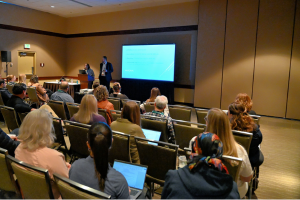
By Katie Rendon, MA, Registrar, Hebrew Union College
“Rules, Regulations, and Laws, Oh My!” was a well-attended session at this year’s annual meeting presented by Erin Mason, University Registrar at the University of Utah, and Sam Carrell, University Registrar at the University of Maine. As the presenters shared, many registrars only learn about rules and regulations the hard way: when something goes wrong.
Instead, we need to work to be proactive and learn as much as we can about rules, regulations, and laws. That preparation can help us be grounded in our own work while also training others on the importance of compliance.
There are many sources of rules, regulations, and laws that one must consider:
Federal laws and federal agency regulations
State laws and state agency regulations
Local ordinances
Accrediting agencies
Professional organizations
Contracts (i.e., with vendors or unions)
Campus or system policies
MOUs and articulations
When you’re ready to emphasize compliance in your work, the presenters recommend a few action items:
Scan your institution’s current attitudes toward compliance and identify others on campus who will be your partners and allies. Continue to build relationships with others on campus to build up your compliance alliance.
Read all of the information you can; this might include publications, association newsletters, or legislative updates.
Recognize sources of liability or concern with your current processes.
Keep working to build grassroots support and communicate the importance of compliance.
Gain a seat at the table where decisions are made, or build your own table. If you have to build a table of your own, the presenters recommend setting your own meetings or sending proactive compliance advice to others until people associate your feedback as an important part of the compliance process. If no one will listen to your compliance advice, keep offering it anyway.
Document conversations that you’ve had and warnings that you’ve given. Keep mentioning issues in any meetings you can; eventually, someone may listen, and you will have shown that you’re doing your part to mitigate risk.
The following list is extensive, though not exhaustive, and shows the scope and variety of rules, regulations, and laws we must consider. As higher education leaders, it’s our responsibility to familiarize ourselves with compliance work while also advocating for policy compliance. If your institution does not currently have a strong culture of compliance, this type of list may help you approach your leadership and advocate for hiring compliance professionals. It’s important for institutions to understand that compliance work is a skilled profession and staff need continued support and training to keep up with changing regulations.
Federal
National
Athletics: NCAA, NAIA, NJCAA
Accreditors: institutional & programmatic
Reporting: NSLDS, IPEDS
Professional Organizations: American Bar Association, Association of American Medical Colleges, etc.
State
Local/Municipal
County ordinances
City ordinances
Campus/System
Catalog
Handbooks
Codes
Human Resources
Conflicts of Interest
Donors & Alumni Groups
Contractual
Unions
Insurance
Vendors
MOUs/Articulations
Partnerships
Compliance is precise and ever-evolving work, but together, we can protect our institutions through knowledge and advocacy.